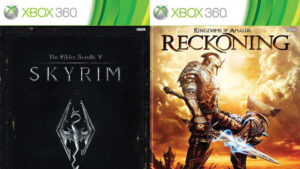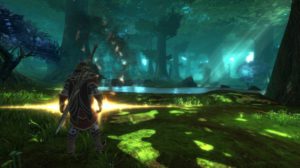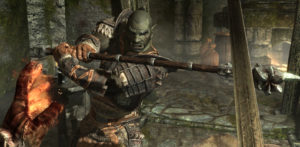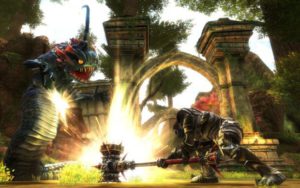Posted by Clark Kent Without Glasses in Review, RPG | 0 Comments
Kingdoms of Amalur and Skyrim
Kingdoms of Amalur: Reckoning and The Elder Scrolls V: Skyrim
Both Kingdoms of Amalur and Skyrim are big, sprawling fantasy RPGs with long, epic-sounding names set in deeply detailed worlds of mythical lore. You’ve got to love them!
After the immense success of 2006′ The Elder Scrolls IV: Oblivion, it came as no surprise that the announcement of its sequel was met with an unprecedented level of hype (at least, for an RPG), as this wonderful animation aptly suggests.
When Skyrim was finally released, it was hailed by legions of fans, sold millions of copies and got awarded multiple awards, including Game of the year at the VGAs. More than a game, it’s really an incredible world in which to inhabit, explore and kick butt.
But who would have thought that only a few months later, from an entirely new developer, a fresh new little game that received little media attention would be released… And that it would turn out to be so good it deserves to stand right next to Skyrim? I certainly didn’t, but about 15 hours in, Kingdoms of Amalur: Reckoning has me gasping: “this thing is good… Really good! In fact… It may be as good as Skyrim!”
I’ll try and compare the two games and explain why I feel they are incredibly similar, completely different and both totally awesome.
Let’s start off with the main character in both games: the world. Both Skyrim and Amalur present untamed fantasy worlds full of lore, but they are very different in tone. Where Skyrim deviates from Oblivion‘s idyllic Arthurian landscapes by going for a rugged, harsh, Germanic feel, Amalur goes in the completely opposite direction, embracing deep and vibrant colours and crazy, over-the-top designs.
The land of Skyrim combines Germanic mythology, the heavy influences of Tolkien and the wild landscapes of actual Scandinavia and incorporates them seemlessly into the already existing Elder Scrolls lore. The landscape is varied, ranging from golden autumnal forests to unforgiving frozen wastelands. On the whole, though, the world can be described as highly realistic and steeped in a sense of grim history. Jeremy Soule’s magnificent music score accompanies the player on his journey, appropriately switching between melancholy beauty and fierce Nordic aggression. Crumbling ruins, ancient standing stones and sleepy wooden villages dot the landscape, which is elevated by enormous, snowy mountains, where mist and clouds roll menacingly through the chilling air. It may be the most immersive world ever constructed for a video game.
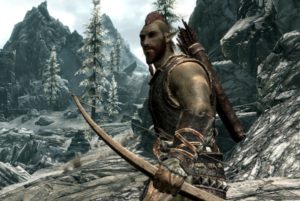
The world of Amalur is not rendered with Skyrim‘s sense of detail and realism, opting instead for a more stylised, “cartoonish” look. Nevertheless, it manages to be surprisingly immersive and evocative in its own right by fully embracing the possibilities that come with its lack of realism. This is a world that truly feels fantastical. It is colourful, varied and very magical. Golden sunrays pierce through the forest canopies accompanied by magical, Elfman-esque music, Fae buildings are constructed out of giant leaves and roots and monsters take on impossibly grotesque proportions. There are some wonderfully original designs here, including organic, plantlike underground tunnels and luminous jellyfish visible through the windows of deep caves. Every environment in Amalur seems to be of enormous size, including, of course, the ridiculously oversized weapons the player’s avatar will be carrying around. While this can be silly, sometimes it also lends a sense of grandeur to things. It’s exciting, for example, to discover that that little dungeon turns out to be a huge cavern that looks out on a faraway underground city.
Of course, where Amalur‘s dungeons may provide these massive panoramas wherever it pleases, Skyrim has the advantage of knowing that it’s actually possible to at least try and explore everything you can see in the world. Except for the very edges of the map, there are no invisible walls in Skyrim. It truly is a fully explorable world, whereas Amalur is really constructed out of a rich and complex system of tunnels that look like they are wide and open environments, but are actually much more constraining than they seem. This is indeed limiting, but it also makes Amalur easier to navigate and find your way in. Still, when it comes to the sheer sense of exploration, Skyrim wins easily, even though Amalur has an even more varied and fantastical world.
When it comes to the actual gameplay, a brief description might have the games seem surprisingly similar, although the actual experience of playing them feels remarkably different. Both games offer a big world to explore, where helpless NPCs beg the player to solve all of their problems and factions or guilds offer a promising career performing specialised missions of magic, stealth or pure combat. Skyrim and Amalur also allow players to use smithing, enchanting and alchemy to craft their own items. Finally, both games offer the freedom to build any kind of character players want to, ditching the old D&D class system in favour of skill and ability trees, allowing us to decide for ourselves how to invest in them. Knowing that the lead developer of Amalur was also one of the main designers of Oblivion of course helps to solve the mystery of the uncanny similarities. Still, despite all of this, Amalur plays like a very different game than Skyrim. The biggest difference is certainly in the combat.
I have heard that many gamers complain about Skyrim’s combat. To be perfectly honest, I don’t see the problem. I actually enjoy it a great deal. Nevertheless, it is certainly true that Kingdoms of Amalur offers a more explosive, fluid and spectacular experience in this regard.
In Skyrim, fighting with shields and swords feels like you are indeed wielding heavy steel objects. Raising an axe and crashing it down into your enemy is intense but slow, reflecting the weight and required strength. Daggers are more fluid but less powerful and bows are excellent for striking while hidden. Besides bashing a shield or taking the time to perform more powerful attacks, there aren’t many special moves or combos, although every once in a while, a critical hit will result in a brutal but satisfying kill animation from a third-person perspective. Moving around on the battlefield is a relatively stiff affair, but other than that, I personally feel that the combat in Skyrim can be described as realistic.
Kingdoms of Amalur offers a vastly different combat experience, one that is more akin to action games like God of War and Castlevania: Lords of Shadow. Wielding weapons three times the size of the character itself like they’re made of paper, characters will roll around, teleport, unleash fiery explosions or call forth the very fury of the earth itself to vanquish their foes. It is far from realistic, but it is incredibly varied, fast, intense and totally badass. As you defeat enemies, you collect their fates, filling a meter that, once full, allows you to enter reckoning mode. In this mode, time seems to slow down as you blithely hop from enemy to enemy, finally finishing them off with a fierce blow, accompanied by a quicktime event that grants you up to double the normal amount of experience points. It’s very actiony indeed, but it works amazingly well within the RPG framework. Leveling up provides opportunities to learn new combinations or special attacks, making the available range of things to do in a fight an ever-expanding treasure trove of violence. Not only is combat fun, it becomes more and more so as you go on.
Of course, while vanquishing enemies and leveling up is a huge part of games like this, it is not all they have to offer. As mentioned before, both games offer crafting systems and I have to say, they are both very good at it compared to other single player RPGs such as Dragon Age. Besides crafting, loot is also a big part of the fun. In Skyrim, loot is both believable and exciting, with the best items being quest-related. This makes sense, as the fabled sword of legend that so-and-so wants you to find is more likely to be an amazing thing to put in one’s collection than some random weapon in a chest somewhere. Amalur probably has more variety in its items but, so far at least, Skyrim’s unique weapons have somehow felt more legendary and special, maybe because in Amalur, massive and extreme-looking stuff is quite simply all over the place.
The Elder Scrolls as a series has existed since 1994 and it has clearly grown from being a relatively run-of-the-mill fantasy setting to one of, if not the most tastefully designed and deep fantasy worlds in video games. Skyrim is dripping with lore that encompasses every aspect of its rich universe as is evident when you read the many books found throughout the game.
Kingdoms of Amalur takes place in a completely new setting, but it was created by R.A. Salvatore, a man who has written many novels set in D&D’s Forgotten Realms setting, including the popular Drizzt series. He knows epic fantasy, he knows lore and it shows. I actually feel that the history, mythology and politics of this world are as deep, mysterious and exciting as what we get in Skyrim. That’s quite amazing for something so new. Whereas Skyrim feels distinctively Scandinavian, Kingdoms of Amalur seems to have a lot of Celtic influences, drawing a lot from Irish folklore with its inclusion of the Fae: immortal elflike beings with a deep connection to the seasons. The theme of fate is at the core of the game’s setting and main story. Everyone in the world has a set fate, one that can be gleaned by certain gifted individuals known as Fateweavers. All of this changes when a dead person is revived by a magical contraption known as the Well of Souls. This person seems to have no fate, and perhaps because of that, can change the fates of everyone else simply by crossing their paths. This person is you, of course, and it makes for some interesting encounters and story points. I have nowhere near finished Kingdoms of Amalur yet, but I find its story intriguing and its themes of fate and free will quite appropriate material for a good fantasy novel, at times reminding me of Robert Jordan’s Wheel of Time series.
 Skyrim’s story combines epic mythology and dragons with a realistic take on a civil war where neither side has the clear moral high ground. As a result, the player gets to make sometimes very difficult choices and enters some morally ambivalent situations… While still ridding the world of the dragon lord Alduin, the destroyer of worlds, of course. It doesn’t take the political machinations as far as Dragon Age or The Witcher do, keeping the game closer to its mythical Tolkienian roots, but moral quandaries and intrigue certainly do play a bigger role here than they did in Oblivion. Personally, I love fantasy because it’s fantasy and I hate it when the same political nonsense that pervades the real world starts to dominate fantasy settings as well. I wasn’t bothered by the civil turmoil in Skyrim though, probably because it is just one part of such a richly imagined world. What’s amazingly well done, is how the separate narratives of the main quest, the civil war, the daedric quests and the various guilds create completely separate experiences with vastly different overtones, all while being set in the same place. When you add them all together, you get an impression of Sky
Skyrim’s story combines epic mythology and dragons with a realistic take on a civil war where neither side has the clear moral high ground. As a result, the player gets to make sometimes very difficult choices and enters some morally ambivalent situations… While still ridding the world of the dragon lord Alduin, the destroyer of worlds, of course. It doesn’t take the political machinations as far as Dragon Age or The Witcher do, keeping the game closer to its mythical Tolkienian roots, but moral quandaries and intrigue certainly do play a bigger role here than they did in Oblivion. Personally, I love fantasy because it’s fantasy and I hate it when the same political nonsense that pervades the real world starts to dominate fantasy settings as well. I wasn’t bothered by the civil turmoil in Skyrim though, probably because it is just one part of such a richly imagined world. What’s amazingly well done, is how the separate narratives of the main quest, the civil war, the daedric quests and the various guilds create completely separate experiences with vastly different overtones, all while being set in the same place. When you add them all together, you get an impression of Sky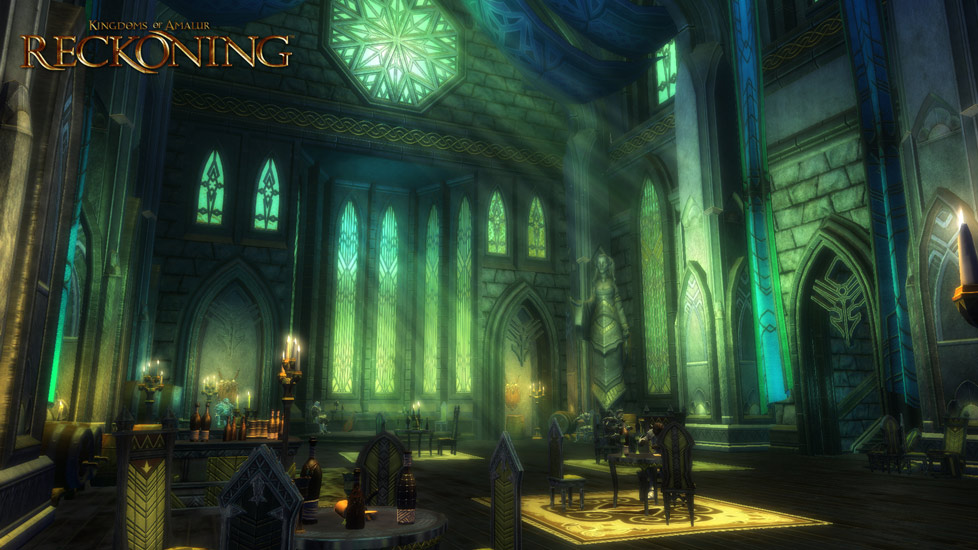 rim as a beautiful, harsh, brutal, ancient, deeply corrupt and unstable but thoroughly magical world whose future is very uncertain. It is certainly very different from Kingdoms of Amalur’s lighter, more heroic approach, although the latter game also has an element of Tolkienian melancholy when the Fae start to realise that the order of the world is truly changing.
rim as a beautiful, harsh, brutal, ancient, deeply corrupt and unstable but thoroughly magical world whose future is very uncertain. It is certainly very different from Kingdoms of Amalur’s lighter, more heroic approach, although the latter game also has an element of Tolkienian melancholy when the Fae start to realise that the order of the world is truly changing.
In short, my recommendation for anyone who enjoys video games, roleplaying games and fantasy, is to play both of these. I personally think that together, they offer as much content and much more fun than any MMO. And for a much lower price, at that.

